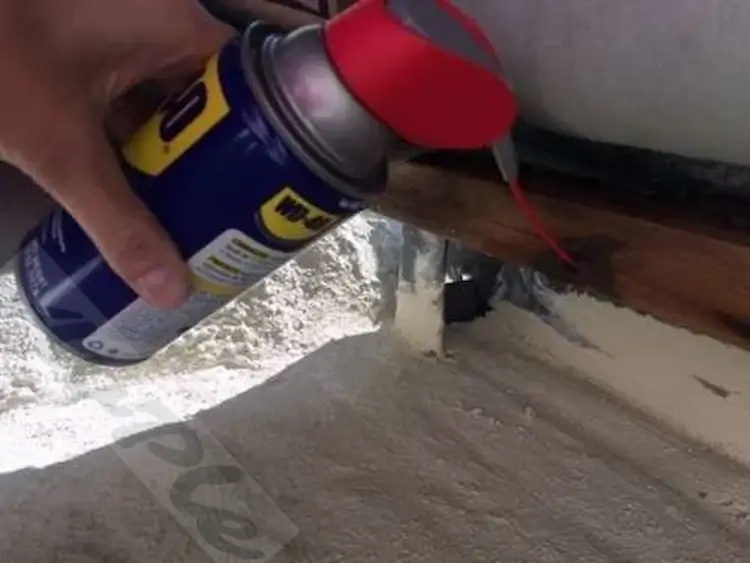WD-40 is an effective and affordable way to get rid of carpenter bees. The key is using the right technique to ensure the WD-40 makes direct contact with the bees. This comprehensive guide covers everything you need to know, from understanding carpenter bee behavior to implementing a successful WD-40 treatment plan.
Key Takeaways
- Apply WD-40 directly on the carpenter bees to kill them
- Spray late at night when most bees have returned to the nest
- Plug entrance holes after treatment to prevent re-infestation
- Use proper safety gear like gloves, goggles, and a mask
- Retreat nests if new bees emerge from existing holes
An Introduction to Carpenter Bees
Carpenter bees (Xylocopa spp.) are large, hairy bees that drill holes in wood to make their nests. They get their name from their woodworking abilities using strong mandibles.
There are two types of carpenter bees:
- Female carpenter bees – Responsible for drilling new nesting holes. They have a stinger but rarely use it.
- Male carpenter bees – Mainly focused on mating. The males are harmless as they do not have a stinger.
Female bees cause the most damage by tunneling into wooden structures. Their holes weaken structures and allow water damage.
Signs of a Carpenter Bee Infestation
Here are the most common signs of carpenter bees:
- Perfectly round holes (about 1 cm wide) in woods
- Piles of coarse sawdust near holes or on the ground
- Large bees lingering or flying around holes
If you notice these signs, you likely have carpenter bees and should take action. The next section covers using WD-40 as an affordable, straightforward treatment option.
Using WD-40 to Control Carpenter Bees
WD-40 works by suffocating carpenter bees upon direct contact. When sprayed directly on the insects, the solvents in WD-40 overwhelm their breathing systems.
The proper technique is crucial for success. You must spray bees directly as they will not be affected by residual WD-40 left around nesting holes between applications.
Follow these steps when using WD-40 against carpenter bees:
Safety First
Use appropriate safety gear when treating carpenter bee nests:
- Gloves – Leather gloves protect against stings from female bees
- Eyewear – Goggles prevent WD-40 and sawdust getting in your eyes
- Mask – A simple dust mask prevents inhaling fine sawdust
Choose Your Timing Wisely
The best time to treat bee nests with WD-40 is late at night when most bees are less active and inside their tunnels. Ideal treatment times:
- Dusk – Many carpenter bees settle down for the night
- Early morning – Cool temperatures keep bees less active
Avoid treating nests in the heat of midday when bee activity peaks.
Directly Spray Bees
Have your WD-40 spray bottle ready at nest entrances. When you spot bees entering or exiting holes, take aim and spray them directly. This method will provide immediate and dramatic results.
It helps to have a friend or family member to assist with properly timing the WD-40 sprays.
Plug Holes
After treating active bees, plug holes with wood putty or caulk. This prevents new bees from taking up residence in existing tunnels. Monitor plugged holes for 1-2 weeks and retreat if bees chew their way back out or emerge from an alternate hole.
Tip: Write dates near sealed holes with a marker to track treatment progress.
Persistence Pays Off
It often takes repeated, direct WD-40 applications to fully eliminate carpenter bees. Don’t be discouraged if you don’t get every last bee on the first go-around.
Check nesting areas at dusk and dawn over the following days and retreat active holes as needed. Remaining bees and newly emerged insects will be vulnerable to sprays during these times.
Prevent Future Infestations
Regular inspections, prompt treatment, and proper prevention reduce the need for extensive WD-40 use:
- Inspect eaves, roofs, decks, and outdoor structures for new holes monthly
- Fill small holes with caulk and paint to camouflage (deters egg-laying)
- Store/stack firewood away from buildings
Alternative Treatment Options
While WD-40 is low-cost and effective for managing bees, other options include:
| Method | Process |
|---|---|
| Insecticide sprays | Residual sprays made to kill wood-boring insects |
| Shop vacuums | Attaching a vacuum hose to entrance holes to suck out bees |
| Professional pest control | Hiring an exterminator to remove bees and nests |
Insecticide liquids or dusts that remain effective for weeks after application provide longer-lasting control. However, many formulations containing Permethrin, Bifenthrin, or other chemicals have been linked to bee population decline. Use the least toxic methods first whenever possible.
Final Verdict
WD-40 makes an excellent repellent and killer for carpenter bees. Follow the techniques in this guide of directly spraying bees, plugging holes, monitoring nest sites, and repeating treatments to fully clear an infestation. Remaining vigilant afterwards and performing preventative measures reduces the chances carpenter bees return.
Implement this comprehensive WD-40 treatment plan as soon as you observe these destructive pests around your property. Doing so will help get rid of carpenter bees and protect your valuable wooden structures from further damage.

Mark Thompson, a seasoned pest controller, is renowned for his expertise in keeping homes and businesses free from unwanted intruders. With a passion for environmental sustainability and a deep understanding of pest behavior, Mark has become a trusted authority in the industry.
